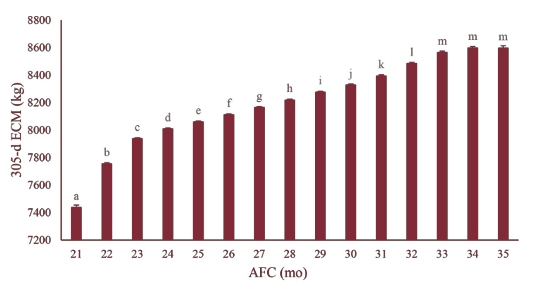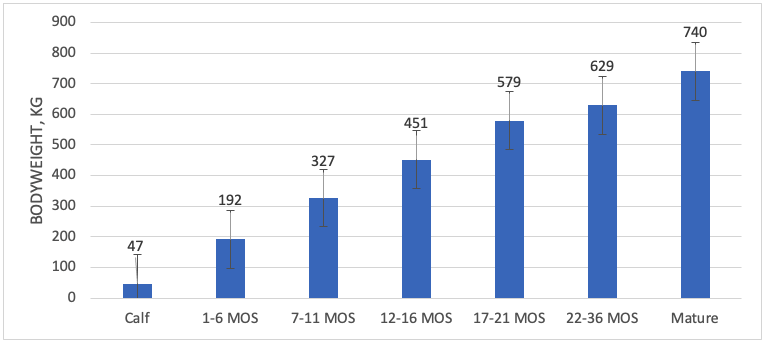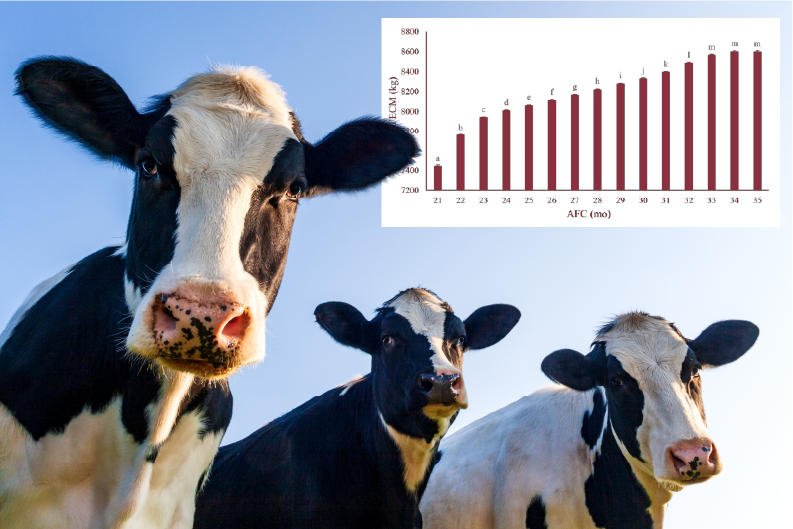
By Hannah Simpson
Summer Intern
Grand Valley Fortifiers
As dairy producers, nutritionists, and sales representatives all know, heifers are the future of the milking herd. Since heifers are the future of any dairy operation, striving for optimal nutrition and management practices to ensure they are reaching their full genetic & milk production potentials should be a primary goal. Unfortunately, this is not the case for many farms. We tend to take good care of newborns, but once calves are weaned, we often forget about them until they have entered the milking herd. As the cost of rearing a heifer continues to rise, breeding younger and getting the heifer in the milking herd quicker can become tempting. The evaluation of heifer success has traditionally been tied to reproductive efficiency by chasing the age at first calving, however, this method is not always the most profitable and reduces the animal’s lifetime productivity. This is demonstrated in Figure 1, where 305-d Energy Corrected Milk is shown by age at first calving (months). Calving too early has significant negative impacts on milk production, however, calving too late can impact your economics, so finding a balance provides you the best of both worlds by focusing on breeding based on weight, rather than age.

Figure 1. Impact of Age at First Calving on 305-d ECM (Graph from Van Eetvelde et al., 2020)
Why do we care about heifer growth?
Although heifers begin cycling around 6 months of age, they do not have enough body structure to maintain a healthy pregnancy. To have a successful pregnancy in a heifer, and achieve optimal lifetime milk productivity, you need to be breeding after they have reached puberty. Many producers aim to breed their heifers at a certain age, so they can begin their first lactation by 2 years of age and start paying back. Despite a heifer being mature enough to maintain a pregnancy once puberty has been reached (typically 9-11 months), they may be too small, which results in poor performance in both first & future lactations. To set up our heifers for success, producers should aim to breed their heifers when they are at 55% of the herd’s mature cow body weight. Prior to calving, heifers or springers, should weigh in at approximately 85% of the herd’s mature cow body weight in order to achieve their full genetic potential for first lactation milk production.
The size and health status of heifers calving into their first lactation is highly associated with first lactation performance; a heifer that is calving at 85% of her mature body weight will have a far more productive first lactation than a heifer who has calved in smaller.
The next time you go to breed a heifer, remember the following:
1. Heifers who are undersized at first calving will put more energy towards energy intake & GROWTH than to MILK PRODUCTION (Overton, 2010)
2. More milk in first lactation = greater lifetime productivity! (Overton, 2010)
*KEY POINT – Do not stunt your future milking herd by breeding heifers too small!
Grand Valley Fortifiers summer 2023 heifer project findings:
Although the importance of good heifer growth on milk production is clear, they are often the forgotten ones or where farms tend to cut corners and costs. Grand Valley Fortifiers wanted to create a database of heifer body weights from calf to calving, to determine if farms are reaching growth goals. Based on 840 weight tape measurements across 13 farms, no two farms had similar results with many not reaching growth targets. Farms were selected based on heifers housed where head locks enabled safe measurement. Not all farms were Grand Valley customers to eliminate bias around feeding programs. One thing is for sure, heifer success depends on a variety of factors such as genetics, plane of nutrition, and farm management practices. It is difficult to manage something that is not measured and taking the time to measure your heifers body weight at breeding and calving, relative to mature cow body weight, allows areas of opportunity to be identified and management changes to be implemented.
Key Findings:
| Age | Body Weight Goal (kg) | Benchmark |
Results |
| Breeding | 407 | 55% of mature BW | 10/13 farms met this target (77%) |
| Calving | 629 | 85% of mature BW | 5/13 farms met this target (38%) |
| Mature | 740 |
Table 1. GVF Benchmarks based on 13 Ontario Farms
5/13 farms met both the minimum breeding and calving size requirements (38%)
3/13 farms had heifers that were too small to breeding and calving ages (23%)

Figure 2. GVF Data across all farms.
How does knowing heifer bodyweights affect management?
Now that we have this data there are several takeaways.
- Measuring heifers can be used to improve accuracy of heifer rations to achieve these targets.
- Ration formulation for heifers is driven off body size, average daily gain goal and dry matter intake. Having farm specific inputs allows nutrition to cater to your farm and your heifers.
- You can identify when your heifers are reaching 55% of mature body weight to ensure you are breeding at the right time.
- You can set growth targets and programs to move your herd in the direction you would like. Based off our measurements to get a heifer from calfhood to bred at 14 months means we need to see an average daily gain of 860 g per day.
- Combine barn management: dry environment, access to good nutrition and clean water and a non-competitive group dynamic.
This is all a part of the puzzle for getting heifers into the milking herd on into the milking herd on time with maximum efficiency and maximum lifetime productivity. Your replacements are your future, so it is important to provide good management and nutrition to heifers from the day they are born, to the day they enter the milking herd. We can’t forget, heifers are still growing while also growing a calf and preparing for milk production, and calving them too immature, will result in the animal focusing on growth over production and ultimately impact what they put in your bulk tank. To see how your heifers measure up reach out
This article was written for the Fall 2023 Eastern Dairy Grist. To read the whole Dairy Grist, click the button below.

